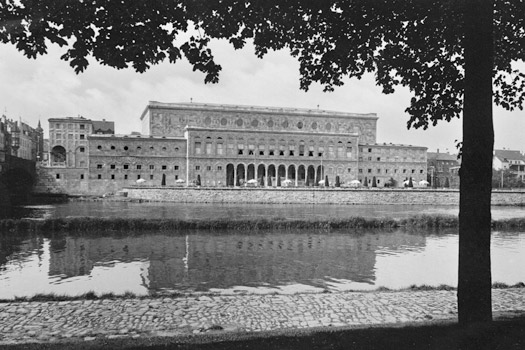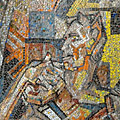
Ein Hauch Venedig an der Ruhr
Mit der Uferbebauung beiderseits der Schloßbrücke gab sich Mülheim an der Ruhr schon in den 1920er Jahren „venezianisches“ Flair.
© Foto Sammlung Ulrich Bücholdt, Bochum
Kunst zurück zur Auswahl
The Mülheim Civic Centre - References to Venetian architectural design give the Ruhr in Mülheim an almost Mediterranean Flair
In 1920 the idea for building a new civic centre took hold and it was not at all usual in the Ruhr Region to use a town's close proximity to the river as an opportunity for enhancing its town planning qualities. Traditionally, the flow of the water had been seen only as a possibility for transportation or as a risk of flooding. Mülheim, however, was before its time in this respect – today the Ruhr gives the city an almost Mediterranean flair. Development began with the construction of the castle bridge (1909 -1911 by Hermann Billing) and the City Baths (1910 -1912 by Karl Helbing). The climax was the construction of the civic centre which was completed in 1926 and was largely the result of the third prize-winning architectural office of Arthur Pfeifer (Karlsruhe) and the architect Hans Großmann (Mülheim), who had enjoyed a good reputation since the planning of the new city hall. The rooms, such as the grand hall, were not designed by Pfeifer and Großmann, but by the Düsseldorf architect and academy professor Emil Fahrenkamp, who was well known for his unusually elegant room designs.
The block-like construction of the civic centre opens toward the bank of the river with a row of arcades; from the colonnade on the eastern side of the grand hall, it is possible to access the waterside terrace. This generous and distinguished combination of architecture and water exudes an air of “Venice on the Ruhr”.
Between 1922 and 1930 further constructions by Pfeifer and Großmann were built on and in the Ruhr, which also made the river itself a stage for sophisticated architecture: the Kahlenberg water power works, what is today known as the “Haus Ruhrnatur”, the administration building for the Rhine and Westphalia water works company, the water station on the Schleuseninsel, and the residential area Luisental continue this “venetian” concept of opening up the city to the river.
Denkmale zum Impuls
Mühlheim - Stadthalle
Nachdem die Stadt Mülheim an der Ruhr Anfang des 20. Jahrhunderts begann, ihre Lage am ... weiter


